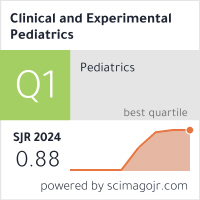- Review Articles
- Recent advances in the diagnosis and management of childhood acute promyelocytic leukemia
- Eun Sun Yoo
- Clin Exp Pediatr. 2011;54(3):95-105. Published online March 31, 2011
-
Since the successful introduction of all-trans-retinoic acid (ATRA) and its combination with anthracycline-containing chemotherapy, the prognosis for acute promyelocytic leukemia (APL) has markedly improved. With ATRA and anthracycline-based-chemotherapy, the complete remission rate is greater than 90%, and the long-term survival rate is 70-89%. Moreover, arsenic trioxide (ATO), which was introduced for APL treatment in 1994, resulted in excellent remission rates...
- Philadelphia chromosome-positive acute lymphoblastic leukemia in childhood
- Hong Hoe Koo
- Clin Exp Pediatr. 2011;54(3):106-110. Published online March 31, 2011
-
In pediatric patients with acute lymphoblastic leukemia (ALL), the Philadelphia chromosome translocation is uncommon, with a frequency of less than 5%. However, it is classified as a high or very high risk, and only 20-30% of Philadelphia chromosome-positive (Ph+) children with ALL are cured with chemotherapy alone. Allogeneic hematopoietic stem cell transplantation from a closely matched donor cures 60% of...
- The treatment of pediatric chronic myelogenous leukemia in the imatinib era
- Jae Wook Lee, Nack Gyun Chung
- Clin Exp Pediatr. 2011;54(3):111-116. Published online March 31, 2011
-
Childhood chronic myelogenous leukemia (CML) is a rare hematologic disease, with limited literature on the methods of treatment. Previously, allogeneic hematopoietic stem cell transplantation (HSCT) was considered the only curative treatment for this disease. Treatment with imatinib, a selective inhibitor of the BCR-ABL tyrosine kinase (TKI), has resulted in prolonged molecular response with limited drug toxicity. Imatinib is now implemented...
- Original Articles
- Novel influenza A (H1N1) 2009 infection in the pediatric patients with hematologic and oncologic diseases in the Yeungnam region
- Seok Jeong Kang, Jae Min Lee, Jeong Ok Hah, Ye Jee Shim, Kun Soo Lee, Hyun Jung Shin, Heung Sik Kim, Eun Jin Choi, So Eun Jeon, Young Tak Lim, Ji Kyeong Park, Eun Sil Park
- Clin Exp Pediatr. 2011;54(3):117-122. Published online March 31, 2011
-
Purpose Natural history and consequences of the novel 2009 influenza A H1N1 (2009 H1N1) infection in immunocompromised pediatric patients are not yet fully understood. In this study, we investigated the clinical features and outcomes of the 2009 H1N1 infection in pediatric patients with hematological and oncological diseases.
Methods We retrospectively reviewed the medical records of 528 patients who had hematological and oncological diseases...
Mycoplasma pneumoniae infection in patients with Kawasaki disease- Mi Na Lee, Jie Hae Cha, Hye Mi Ahn, Jeong Hyun Yoo, Hae Soon Kim, Sejung Sohn, Young Mi Hong
- Clin Exp Pediatr. 2011;54(3):123-127. Published online March 31, 2011
-
Purpose Kawasaki disease (KD) is the main cause of acquired heart disease in children. In addition to cardiovascular involvement, many complications have been recognized in KD. However, respiratory complications have been rarely reported. We investigated the differences in clinical characteristics, laboratory findings, radiography findings, and echocardiography findings of
Mycoplasma pneumoniae infection and other types of pneumonia in KD patients.Methods Among 358 patients...
- Responses and adverse effects of carboplatin-based chemotherapy for pediatric intracranial germ cell tumors
- Suntae Ji, Hee Won Chueh, Ju Youn Kim, Su Jin Lim, Eun Joo Cho, Soo Hyun Lee, Keon Hee Yoo, Ki Woong Sung, Hong Hoe Koo
- Clin Exp Pediatr. 2011;54(3):128-132. Published online March 31, 2011
-
Purpose Cisplatin-based chemotherapy has been commonly used for the treatment of intracranial germ cell tumors (IC-GCTs). However, this treatment exhibits some adverse effects such as renal problems and hearing difficulty. Carboplatin-based chemotherapy was administered to pediatric patients with IC-GCTs from August 2004 at the Samsung Medical Center. In this study, we assessed the responses and adverse effects of carboplatin-based chemotherapy in...
- Case Reports
- Misdiagnosis of fetus-in-fetu as meconium peritonitis
- Yoon Joo Kim, Se Hyung Sohn, Ju Young Lee, Jin A Sohn, Eun Hee Lee, Ee Kyung Kim, Chang Won Choi, Han Suk Kim, Beyong Il Kim, Jung Hwan Choi
- Clin Exp Pediatr. 2011;54(3):133-136. Published online March 31, 2011
-
Fetus-in-fetu (FIF) is a rare congenital condition in which a fetiform mass is detected in the host abdomen and also in other sites such as the intracranium, thorax, head, and neck. This condition has been rarely reported in the literature. Herein, we report the case of a fetus presenting with abdominal cystic mass and ascites and prenatally diagnosed as meconium...
- Testicular adrenal rest tumors in a patient with untreated congenital adrenal hyperplasia
- Hye Young Jin, Jin Ho Choi, Gu Hwan Kim, Chung Sik Lee, Han Wook Yoo
- Clin Exp Pediatr. 2011;54(3):137-140. Published online March 31, 2011
-
Testicular adrenal rest tumors (TARTs) are considered to be formed from aberrant adrenal tissue that has become hyperplastic because of elevated adrenocorticotropic hormone (ACTH) in male patients with congenital adrenal hyperplasia (CAH). A 6-year-old boy presented with testicular enlargement and pubic hair. He was diagnosed with CAH complicated by precocious puberty. However, he was not followed-up. At the age of...















